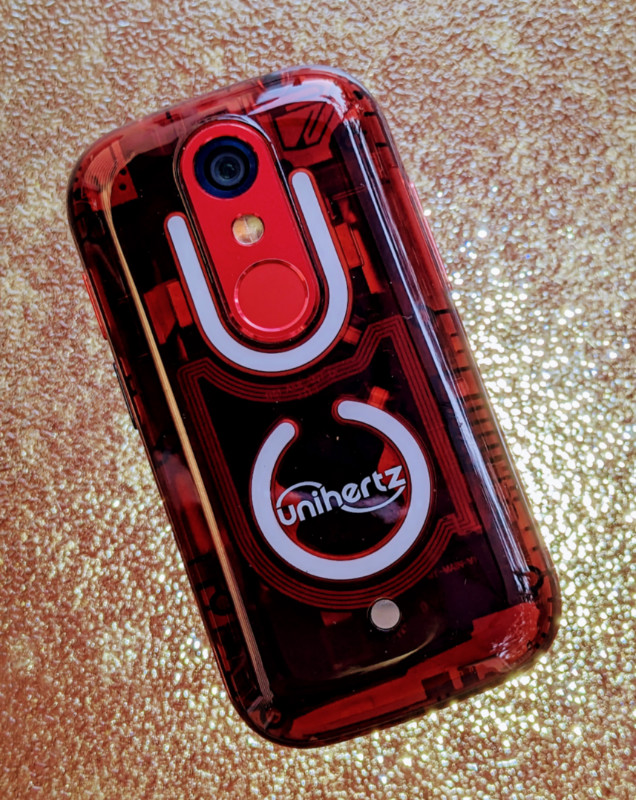
REVIEW – The Jelly Star is a new smartphone from Unihertz being introduced through a Kickstarter campaign starting June 13, 2023 at 8am. The review phone came wearing the current Android 13 OS with an April 2023 security update. The Jelly Star has very respectable specs, and operated in all ways like a modern smartphone. But it has a 3 inch screen and a really tiny onscreen keyboard, so, come take a look if you’re curious, and have very good natural or corrected vision and might like a break from your big, glass, slab-o’phone.
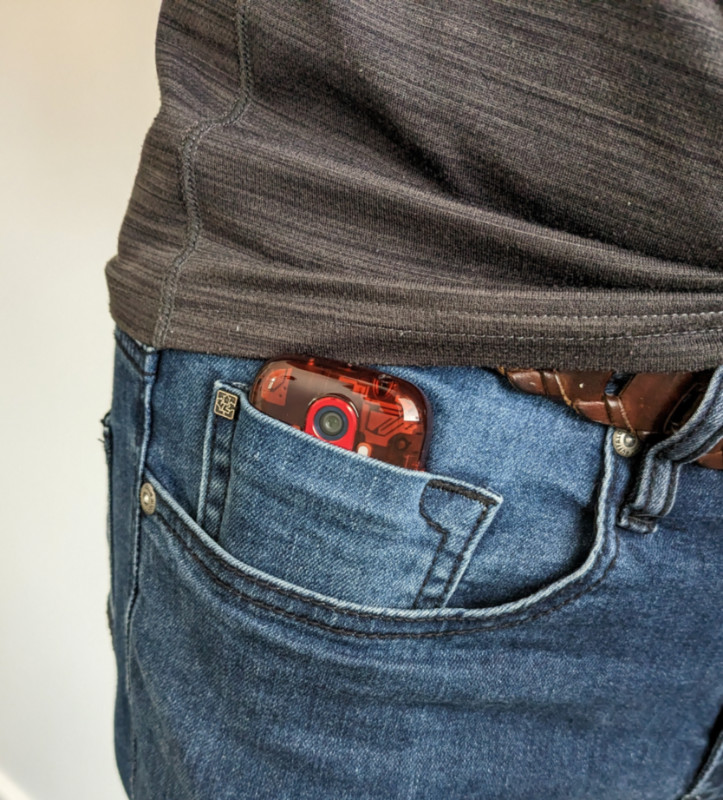
What is it?
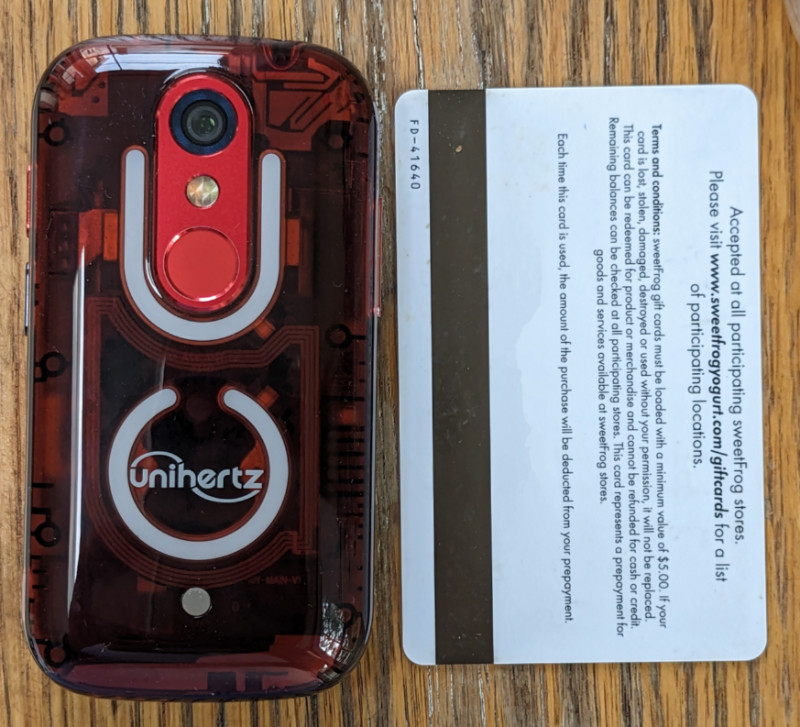
The Unihertz Jelly Star smartphone is a credit card sized phone designed to operate on either the T-Mobile or Verizon 4G LTE networks in the U.S. It is available in ‘see through’ red or blue.
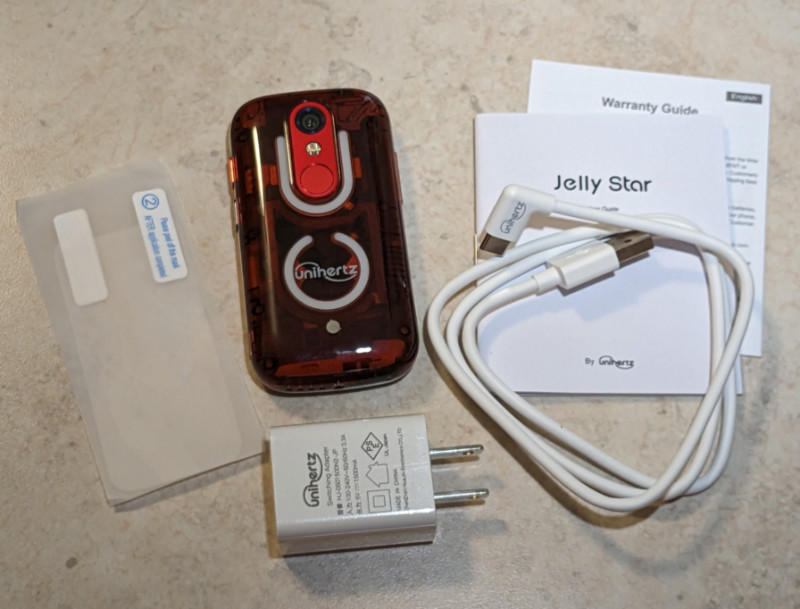
What’s in the box?
- Unihertz Jelly Star smartphone
- USB-A to USB-C cable AND charger
- Lanyard
- Extra screen protector
- User guide
- SIM pin
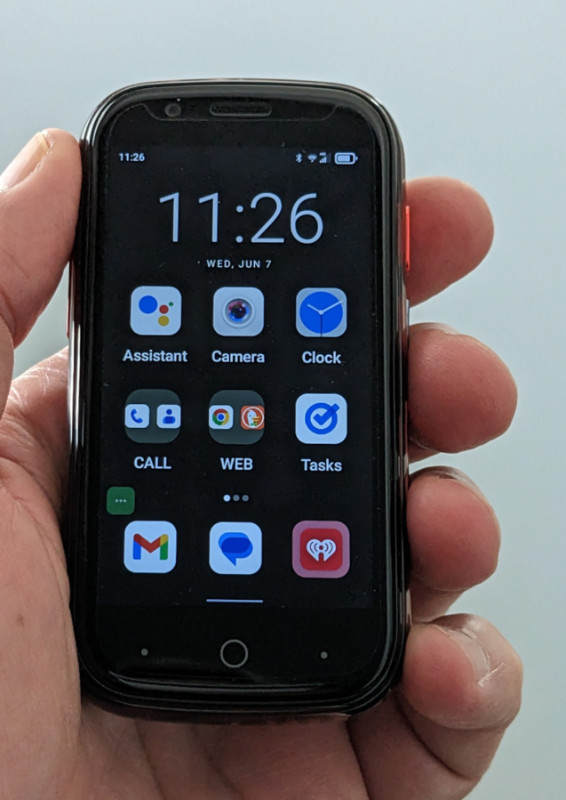
Hardware specs
- Dimensions: H 3.75” x W 1.94” x D .69”
- Weight: 4.3 oz
- CPU: Helio G99 Octa-Core 2.0-2.2GHz
- OS: Android 13
- Memory: 8GB RAM
- Storage: 256 GB ROM UFS 2.2
- Battery: 2000 mAh lithium ion, non-removable
- Charge rate: 10W
- LEDs: Bright single LED, plus dynamic action ‘U’ and ‘O’ shaped
- SIM card type: Dual Nano
- Micro SD capable: Yes
- Screen: Panda Glass, LCD, 2.63” x 1.5” display area
- Resolution: 480×854
- Camera: Rear: 48MP Front: 8MP
- Connectivity:
2G GSM (Band 2/3/5/8)
3G WCDMA (Band 1/2/4/5/6/8/19)
3G CDMA2000 (Band BC0/BC1),
4G FDD-LTE (Band 1/2/3/4/5/7/8/12/13/17/18/19/20/25/26/28A/28B/66
4G TDD-LTE (Band 34/38/39/40/41) - Wifi: WLAN 802.11 a/b/g/n/ac 2.4GHz/5GHz
Wi-Fi Direct, WI-FI Display, Wi-Fi Hotspot(V2.0) - Bluetooth: 5.3
- NFC: Yes
- Navigation: GPS + GLONASS + BeiDou + Galileo
- Sensors: Fingerprint (back-Mounted), G-Sensor, Compass
Gyroscope, Proximity, Ambient Light Sensor - Facial recognition: Yes
- Infrared port: Yes
- USB: Type C
- Programmable key: Yes
- Loudspeaker: Yes
- Headphone Jack: 3.5mm
- Wireless charging: No
- FM radio: Yes
- Color: Transparent red or blue
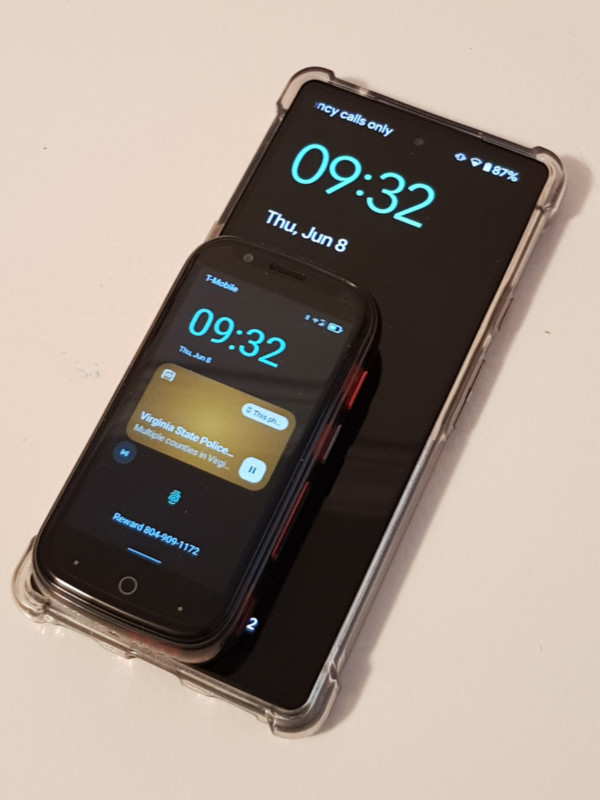
Design and features
We don’t usually review prototypes at The Gadgeteer but with the Unihertz Jelly Star we made an exception. I expected to receive a phone tossed in a padded bag, but the phone came sealed and packaged in what appeared to be ‘market ready’ materials. The silver, logo imprinted, hardboard box was nicely finished, shrink-wrapped in plastic and the top was secured with Unihertz branded security seal tape. A manufacturer label was on the box with the Unihertz logo, IMEI numbers and major phone specs. The box contents were well organized and securely packaged. All to say, if this is a prototype, I couldn’t tell it from how the phone was shipped or operated during my testing. This Jelly Star seems very ready for prime time.
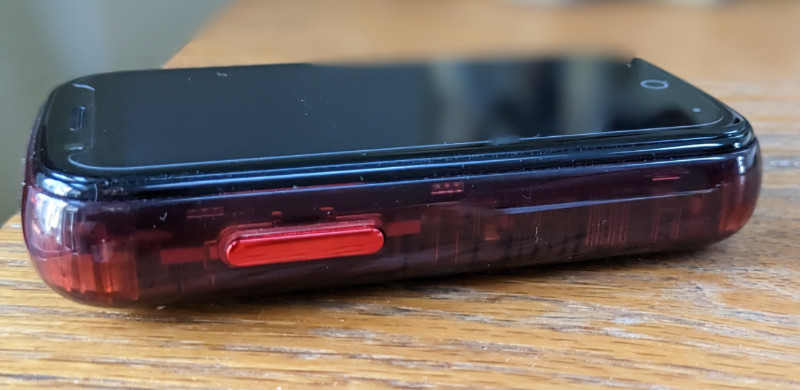
The volume rocker switch is on the left side of the phone.
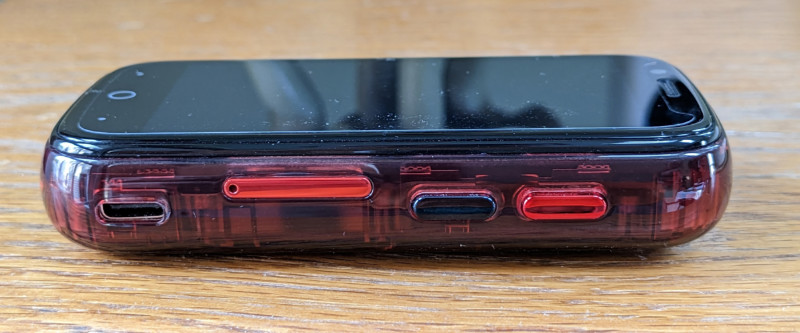
From left to right: USB-C charge port, SIM tray door, programmable button and power button.
The Unihertz Jelly Star arrived with a screen protector installed and a spare one in the box. It is nice to have factory installed screen protection. I haven’t used screen protectors for years since phones I buy have Gorilla Glass or comparable. I’m not as familiar with Panda Glass so I’ll keep the protector in place.
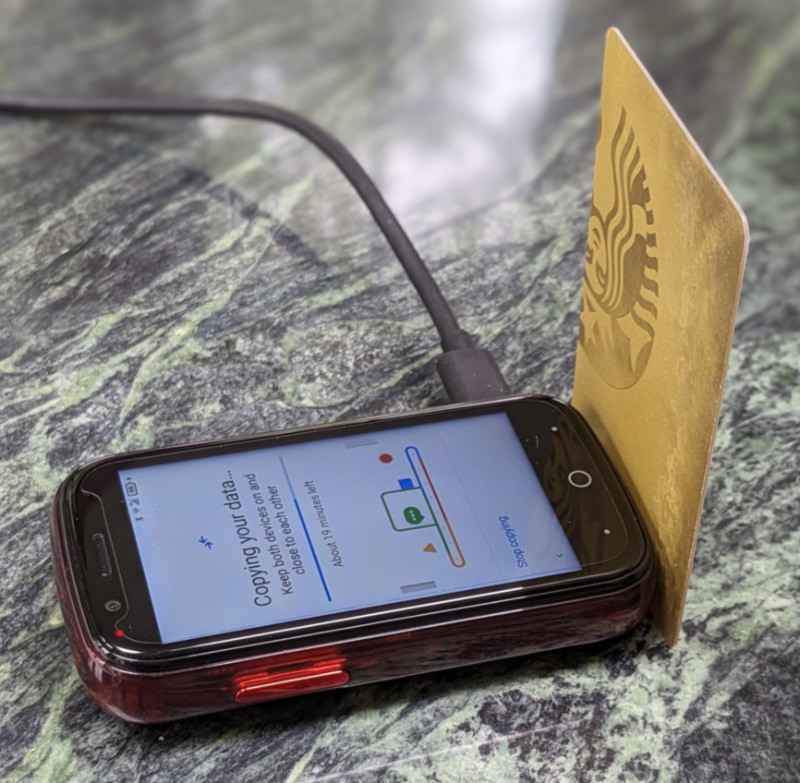
The USB-C charge port is on the lower right side of the phone. That took some getting used to when using the phone during charging.
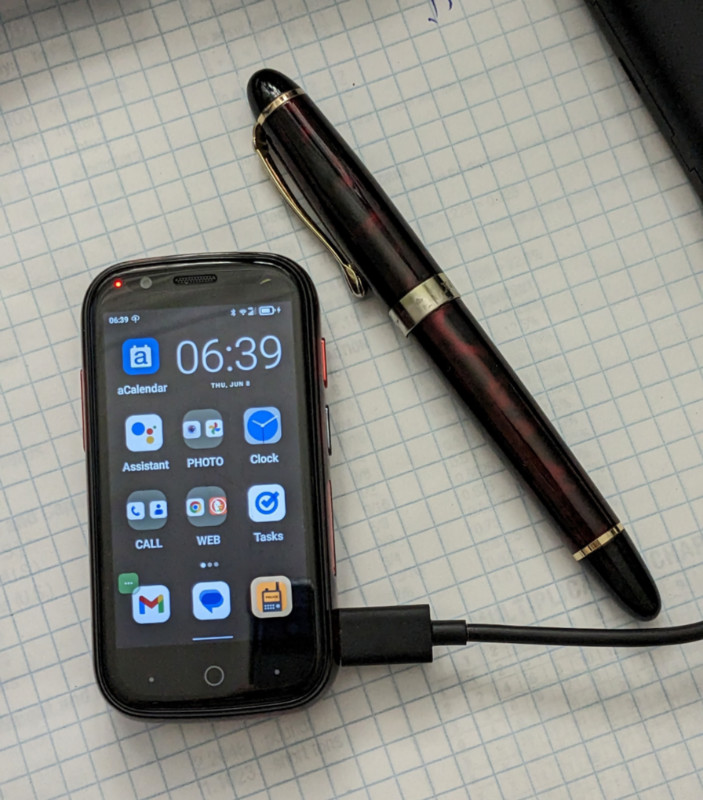
There is a huge 256 GB of built-in ROM storage in the Jelly Star. I installed all the 105 apps I use on my Pixel 6a except for two banking apps and Google Pay, and I’m only using 11% of the storage. Since I didn’t install Google Pay, the setup process with my Pixel phone was the extent of my testing of the Jelly Star NFC function.
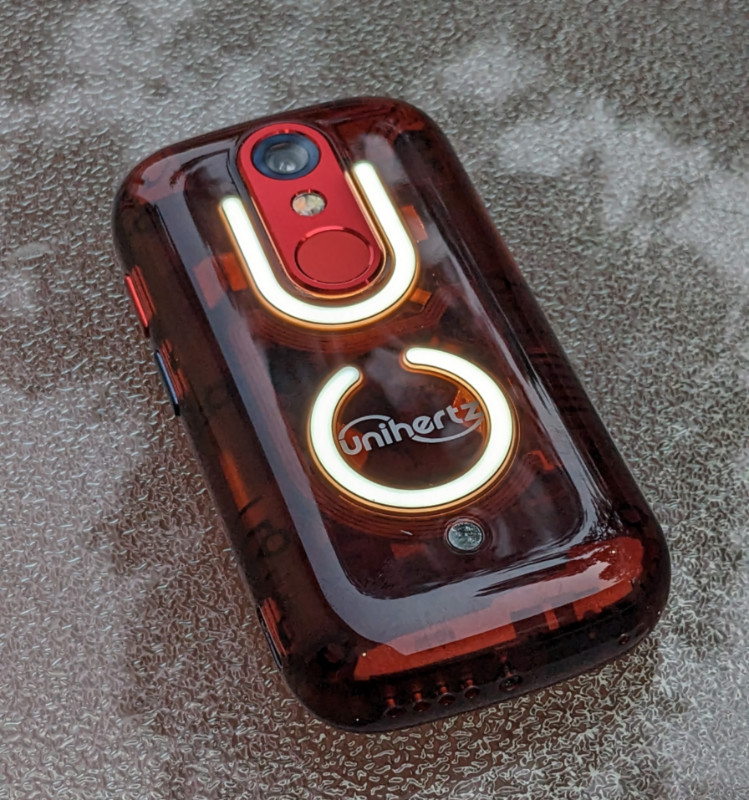
The Unihertz Jelly Star smartphone comes with a translucent red (or blue) plastic shell. The red color is like the shell of a candy apple, or a red lollipop. (No phone was licked in the course of this review.) The plastic does not feel cheap, ‘toy’ quality, or brittle. The phone is solidly constructed and nothing creaks or rattles if I squeeze, press, or shake it.
There is one standard LED on the back of the phone, and two unique ones. The long ones shaped like a ‘U’ and an almost closed circle can be set to flash in rhythm to music (why?) and to flash with notifications that come to the phone. This makes for distinctive notifications without being obnoxious.
The standard LED is used for flash photos, or with a long press of the programmable button, it turns on as a very bright flashlight. The U and circle shaped LEDs can come on as a flashlight by using the LED widget to turn on those lights. As you’d expect, those cast a broader beam. Think of them as an ‘area light’.
Setup
The phone powered on pretty quickly and had 70% battery capacity from the factory.
I plugged the phone into a charger and started the setup procedure. I opted to use the Jelly Star NFC to connect to my Google Pixel 6a to copy apps and settings to the new phone. I have a lot of apps and setup was complete in about 50 minutes. The phone achieved full battery at around the same time. After setup the Jelly Star had appropriately adopted most of my system settings just as I had them on my Pixel. It took another hour to open all the apps that need fresh log-ins on a new device, choose a ringtone, notification tone, and tweak lots of system and app settings.
The Jelly Star has a Unihertz ‘skinned’ Android 13 OS, but it is not irritatingly changed from vanilla Android 13. Everything I needed to find in Settings was in the same place or close to where it is on my Pixel.
My compliments to Unihertz for not loading up the Jelly Star with bloatware. There are 7 Unihertz apps; Clock, FM Radio, NFC Card (add your ‘tap to pay’ cards), SIM Toolkit (says ‘Not ready or not supported’), Sound recorder (handy for voice notes), Student mode (parental controls), and Toolbox (12 small apps like compass, protractor, flashlight, magnifier, bubble level, plumb bob, picture hanger, etc.)
The phone boots up to my SIM PIN screen in 25 seconds, and is operational in 35 seconds after I enter my SIM PIN, then passcode. The Jelly Star is the fastest booting phone I’ve owned.
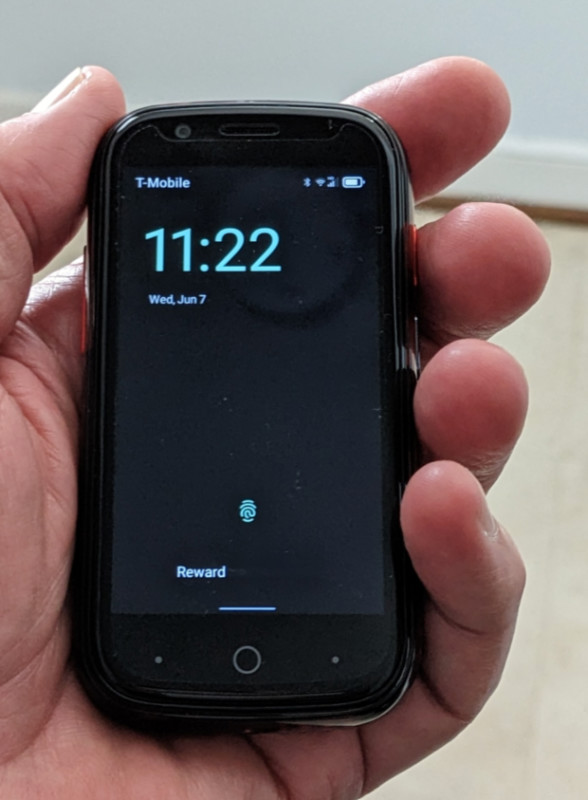
Performance
The Jelly Star comes with a Unihertz lanyard but there is no way to attach it to the phone. Unihertz says it’ll attach to the phone case, which the manual indicates will be included with the marketed devices. The smooth plastic shell of the Star can be slick at times. I wish I had the case but the phone is already nearly ¾” thick so, I was just careful.
The phone does not take super long to charge, but at 10W charging, you have probably seen faster. To get the 2000 mAh battery from 50% to 100% the Jelly Star took about 70 minutes. It achieved 99% charge in 50 minutes but stayed at 99% for about 20 minutes. Maybe this is charging engineering at play? I keep my cellphones between 45% and 85% charge to lengthen battery life. Topping up the Jelly Star to 85% a couple of times during the day seemed fairly quick.
 Perfect color capture in this pic.
Perfect color capture in this pic.
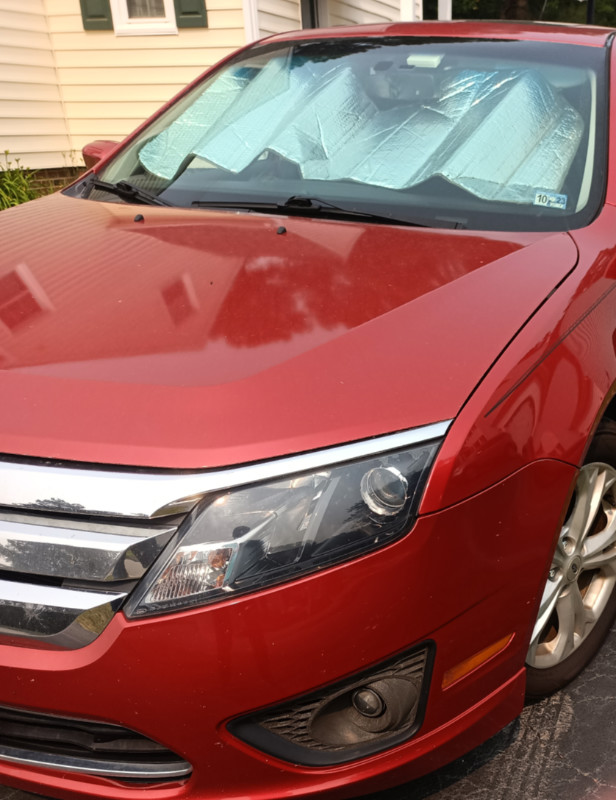 My car is red, not orange or brown. An ‘almost right’ with this pic.
My car is red, not orange or brown. An ‘almost right’ with this pic.
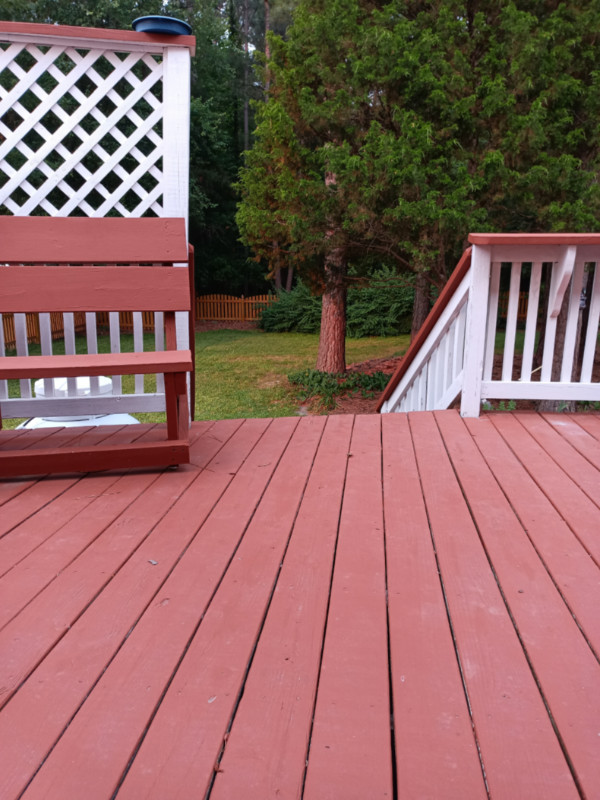 The deck is brick red. Pretty close accuracy with this photo.
The deck is brick red. Pretty close accuracy with this photo.
 The Jelly Star perfectly captured all of the colors in this photo.
The Jelly Star perfectly captured all of the colors in this photo.
Jelly Star camera performance was pretty good in daylight. No one buys a mini-phone for its camera, but the Jelly Star got most colors right or close to right, in my test pics, and the images were all sharp. The camera comes on quickly with a double-press of the power button. This feature was set from the factory and has become a nice standard with several brands. Just don’t count on great low light pics from the Jelly Star.
In spite of ‘Adaptive brightness’ being on in Settings, the Jelly Star screen did not seem to brighten outdoors. I found the screen difficult to see in direct sunlight and even under bright overcast skies. I had to go into the shade to check notifications several times when I was outdoors.
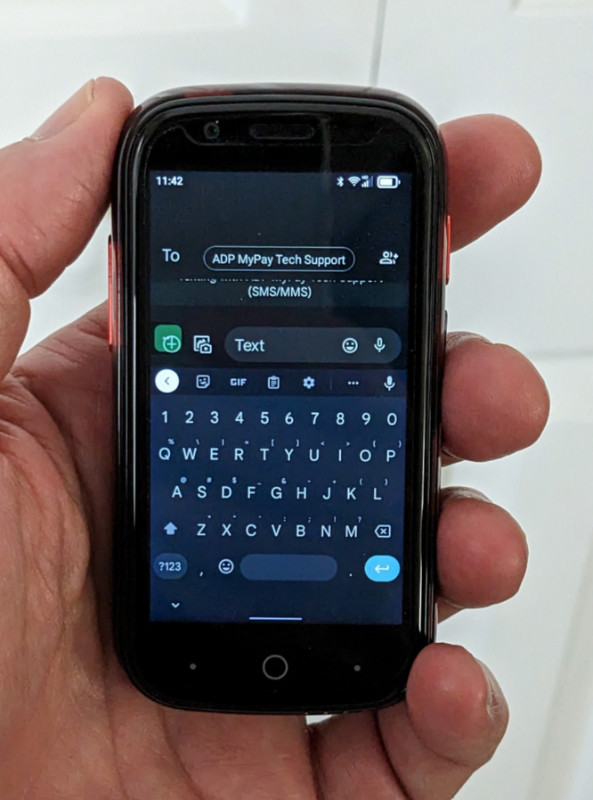
Texting on the Jelly Star was the biggest challenge for me simply because the keyboard is so tiny. It is difficult to write messages correctly with human fingers. Google Messages is my current texting app. Once a text thread is started I can enlarge the text but the keyboard stays tiny. And forget the characters above each key that can be invoked with a long press. I can’t see the itty bitty :;!@#$%. I tried not to exclaim, “:;!@#$%!”
In landscape mode the keyboard is a bit larger, but then I couldn’t see enough above the keyboard to track a discussion thread. Scrolling was difficult in landscape view. Voice typing is an obvious option but I kept hitting zero trying to activate voice typing, and once voice typing is done, you have to read what Google thinks you said and correct it, meaning more squint editing.
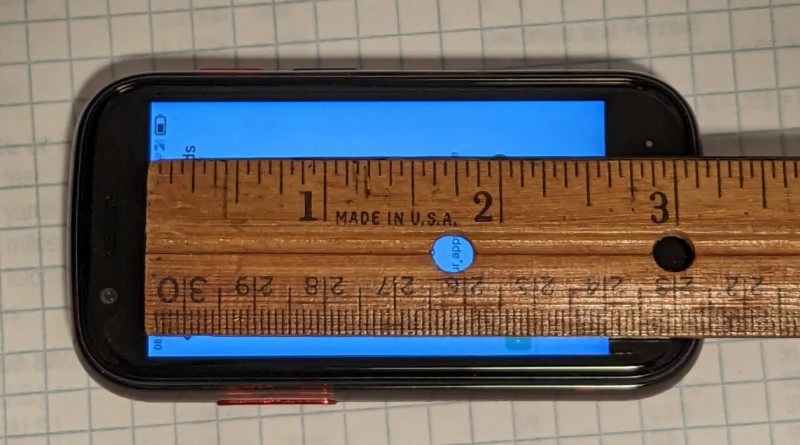
I guess there’s only so much Unihertz can do with a screen this small when it comes to text entry, but text messaging is a critical feature of smartphone use and this is a major challenge to adopting a super-small phone.
The Jelly Star vibration is very light. It was difficult to feel the vibe in my pocket and it doesn’t make much noise. I missed an important call in the car because I’d left the phone on vibrate and heard nothing from it sitting in the seat beside me. The vibe might work for you if you’re in a quiet environment and the Jelly Star is on a hard surface.
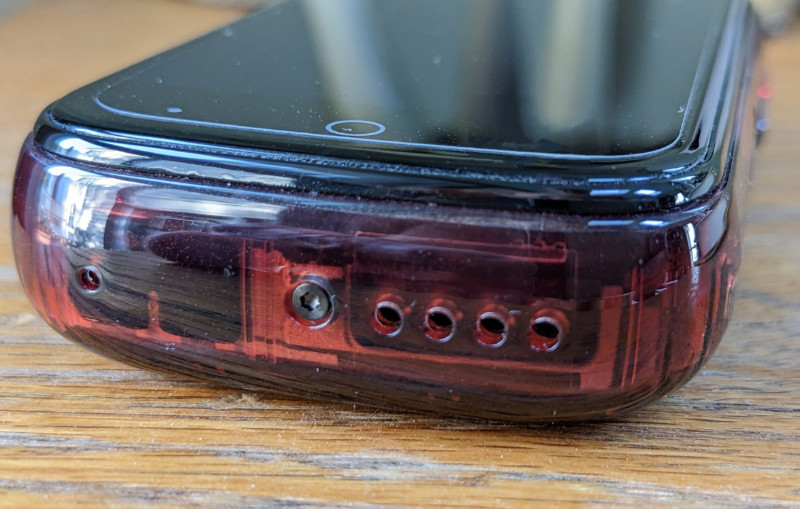
The bottom-firing speaker in the Jelly Star is impressively good and clear, and imparts voice sound as well if not better than my Pixel. There is no speaker scratchiness or raspiness at higher volumes. Multi-instrument music (band or orchestra) played at full volume degraded a bit but was too loud for comfortable listening anyway.
On phone calls no one could tell I was on a different phone vs. my usual, and I heard through the phone’s ear speaker quite well. Unihertz did not cut corners on the Jelly Star’s speaker for normal vocal sound reproduction. The loudspeaker will ‘carry a tune’ just fine but no one gets a credit card sized phone to hear excellent music well. Vocals in music sounded pretty good through the phone’s bottom speaker, but instruments get a bit lost in the mix. I listened to an electric harp solo on the Jelly Star and my wife commented how such a small phone could produce such good sound. When using any of my in-ear earphones paired with the Jelly Star, sound reproduction was as good as with my Pixel phone.
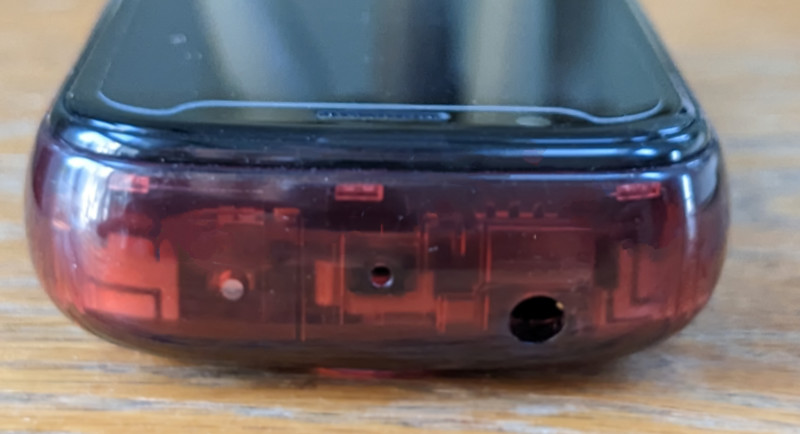 Take this, big phone makers who claim there is no space for an earphone jack! The clear, translucent circle to the left is the IR window for the TV remote app. In the center is the top microphone.
Take this, big phone makers who claim there is no space for an earphone jack! The clear, translucent circle to the left is the IR window for the TV remote app. In the center is the top microphone.
As with most cellphones that have FM radio built-in, it is necessary to use corded earphones (with a 3.5mm jack) to serve as the antenna. In my area we have a powerful AM news-talk station that uses an FM frequency with somewhat low power. The Jelly Star tuned in to that station pretty well inside my house. I turned off wifi to be sure it was really the FM radio doing the reception.
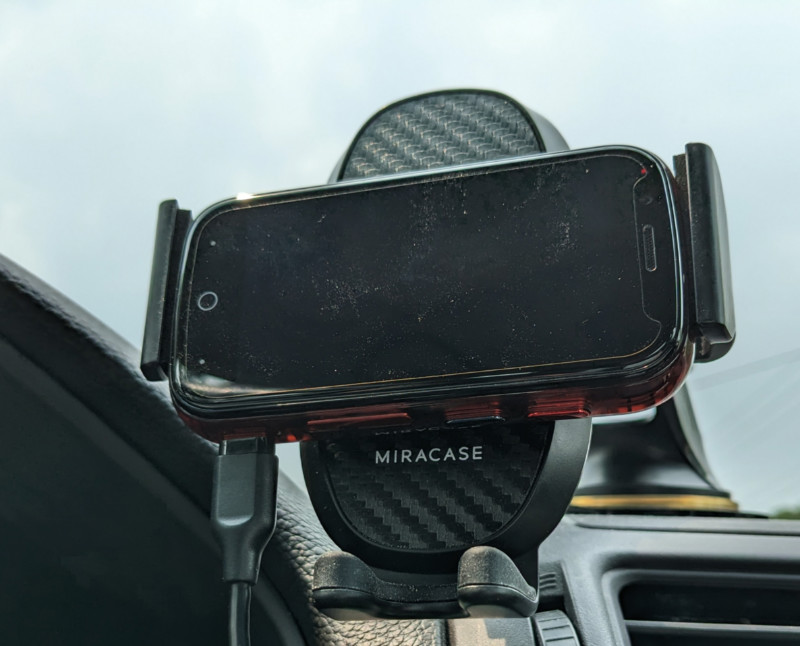
Use of the Unihertz Jelly Star in the car took some thought and modification. The phone is too skinny to be held by my dashboard-mounted cellphone holder. It fit snugly when held in landscape position but GPS was hard to view in landscape view, and the speaker was blocked by one of the grip arms of the phone holder. There is no adequate place to put a steel piece on the back of the phone in order to use magnet mounting. The camera and fingerprint sensor need to be unobstructed and in the center of the circle LED is the NFC antenna, plus I don’t want to cover up that LED. I tried pieces of foam rubber at the arms of the phone to help it grip the tiny Jelly Star but had mixed results. Why not just put the phone in my cup mount? I have two holders in the console and they’re usually both occupied. And due to the charging port location, the Jelly Star couldn’t sit in my cup holder while the charging cord is attached without crimping the cord. I’ll continue to experiment. I’ll probably use a lanyard style name-card holder that has a clear vinyl front pocket like I used to do with rental cars. I can shorten the neck cord and hang it around my phone holder base.
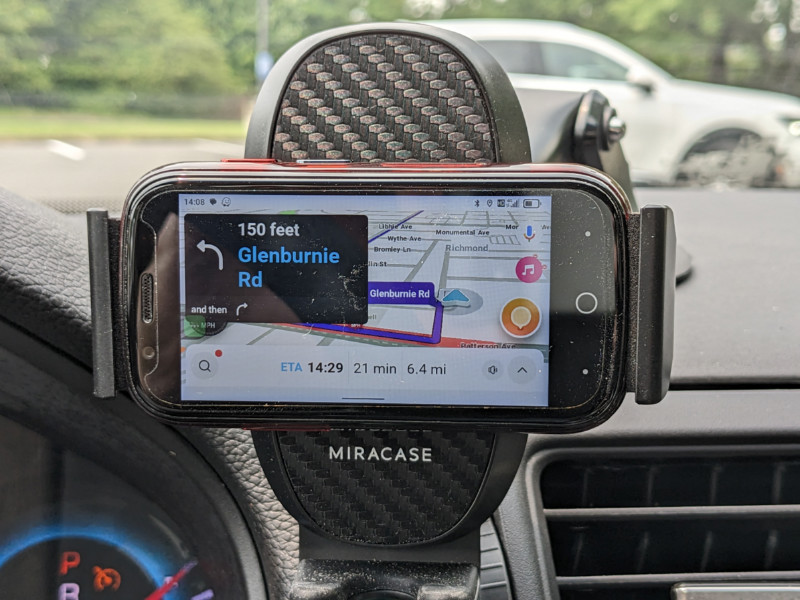
GPS operated perfectly on the Jelly Star during my in-town testing. I use Waze for driving guidance but also tested with Google Maps. Thankfully both apps verbalize directions so I didn’t have to squint at the screen too much. I might have a bit more challenge in unfamiliar territories where I have to pay more attention to the GPS screen.
I encountered no performance lags when opening or using any of my apps, nor when I opened, closed and quickly changed to other apps. The Jelly Star operated as fast as any of the mainstream phones I’ve owned.
Security updates on niche phones of any type are not usually a corporate priority. It’s great to see the current Android operating system and a fairly recent security update on the Jelly Star, but the update future for the Jelly Star remains to be seen.

What I like
- The Unihertz Jelly Star is a fully functional Android 13 smartphone
- Great size and weight
- Surprisingly good loudspeaker and phone call speaker
- Very good battery performance and duration
- Red happens to be my favorite color
What I’d change
- Make a firm commitment to security updates
- Dynamic screen brightness needs improvement
- Stronger vibration module needed
- Texting needs some engineering help
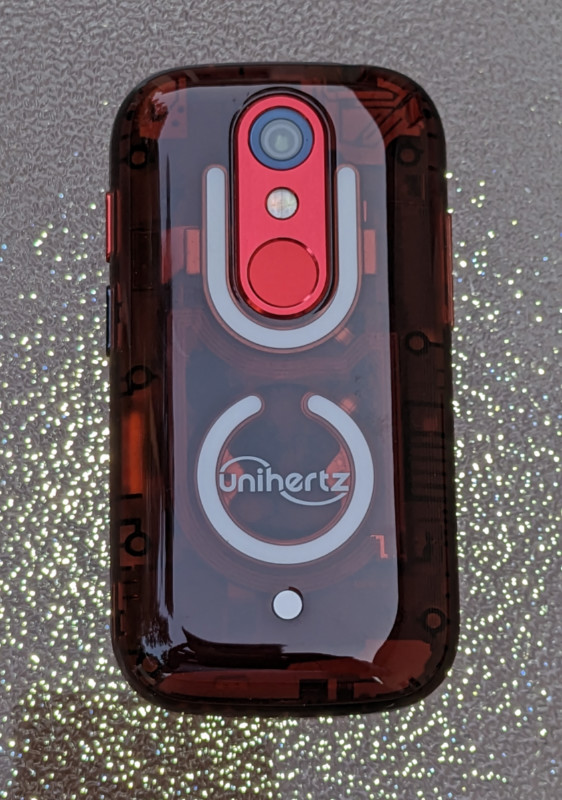
Final thoughts
The Unihertz Jelly Star is an up-to-date Android smartphone with great storage, speed and performance. It has more RAM and storage than my Pixel 6a. In slim-fit dress pants the Jelly Star’s 3/4″ thickness was hard to hide and it was less noticeable in casual pants, jeans and shorts. But my best compliment to any product is if I keep using it after I write a review. I’m not pulling my SIM from the Jelly Star just yet. We just met and seem to be getting along well. At this price point the Jelly Star would be a great backup phone to carry on travel, just in case. The Kickstarter campaign is now starting if you want to jump in at a very nice price.
Update 6/14/25
I reviewed the Unihertz Jelly Star Smartphone in June of 2023. There was a lot of hype and build-up prior to its release about this candy bar sized, fully functional smartphone and it performed quite well.
But since the summer of 2023 it has -never- received one security update. It still bears the update it came with, dated April 2023. The best phone makers send down security updates every 1-2 months. My initial exuberance for this small device eroded as month after month passed with updates not coming.
These niche phones may have a spot on some people’s shopping list but for me, the absence of updates is a firm deal breaker. I long ago relegated this device to being a paperweight and podcast streamer for home use only and that’s still its only purpose.
I have to give a thumbs down on this Unihertz device, and for the company abandoning a product at its launch.
Price: $199.99
Where to buy: Unihertz
Source: The sample of this product was provided by Unihertz.



Gadgeteer Comment Policy - Please read before commenting
Great review!
You mentioned charge times, but how is battery life?
I can’t add much more than how I addressed that in the review. Usage varies so much by individual it’s difficult to give specifics. I used the phone a lot during my review testing and ‘topped off’ the battery 2-3 times per day when it dropped to 50% to 70%. Stand-by time (doing nothing) would be outstanding for the Jelly Star. ‘In use time’ is going to vary by what one does on the device.
You did, but that doesn’t really give me an idea of how the battery life is. Did it feel “good” to you? I’m assuming you weren’t doing anything intensive on such a small screen, so if you’re starting the day around 85%, and getting down to 50%-70% two or three times during the day, battery life doesn’t sound great.
I’d call most of my testing ‘screen on time’ vs. ‘intensive processor stressing’. So my rate of battery depletion was due to me using the phone X hours of the day. I never felt surprised that the battery didn’t last longer, but that said, I ‘topped off’ about 3 times a day during my testing. Due to this screen size I think most people will use the device
as -really- needed and less than they would use a full sized smartphone, and the 2000 mAh battery size will match pretty well for that less intensive use.
which carriers will it support
From the ‘What is it’ section, T-Mobile and Verizon in the U.S.
Does the keybord/screen work with a stylus? If so, which one?
I have one of the original Jelly phones, and I just can’t use the keyboard, so I don’t use the phone. I’ve had mixed success with different stylus. None of them work consistently.
Scott, you’re in luck, I don’t use a stylus any more but I found an old one probably given at a meeting or picked up at the impulse section at an office supply store. It works fine. Maybe that would give someone more accuracy with the very small keyboard. The Jelly Star has a modern, capacitive touch screen as does any current smart phone so any stylus operating on that principle should work.
I do fine with a little one of those black cushioned ‘stylus’ things you can get anywhere, got a box of 50 of them for 14.00 on ebay because I lose them. The point of this phone is it CAN do EVERYTHING you want, stream audio or even video, be SO small and convenient for one handed use, but, it isn’t ideal for a heavy texting day, and of course you must have good vision or good glasses to want this phone. The battery life is decent for its size, streaming talk shows or music while you’re on the run works nice, and it can do any music app just fine. I absolutely love this little phone but it’s not meant to be your ONLY phone, but it can be if you want it to be.
All the “Early Bird” rewards are gone…. lowest price now is $170
hope this battery quality does improve,
in their previous generation of products just really suck asf…
Am going to buy one just to try it out,if I like it I’ll use it as a back up phone.
It looks amazing ! This world lacks (among other stuff, sure) small phones. My phone is still working well but I may end up buying a Jelly star anyway to try it (and support development). About tiny keyboard, for people using their phone when they have a personal computer available too, there is a convenient app called kde connect available that lets you type from the computer’s keyboard, among other features.
I have the Jelly 2E, purchased earlier this year. It’s ok, but really too small. I use speech to text because even my small hands can’t type on that postage stamp of a keyboard. It’s a gimmicky phone, being the smallest of it’s kind. The selfy camera is deplorable. The phone is not at all durable, as the screen cracked after a small fall. The cost of having the screen replaced isn’t worth it. Will I buy another Unihertz phone? Yes, and I already have the Titan Slim which is an excellent phone. Will I buy another Jelly series phone? No.
I just got one of these. If anything I find it less slippery in my hands than larger phones. The small but thick and blobby shape makes it feel more like holding the old “candy bar” Motorola dumbphone I had ages ago. No need to awkwardly prop the bottom edge with my pinkie like I find myself doing with large, flat phones with edge-to-edge screens (when case-less at least). It feels very natural to hold between my palm and fingers.
A tip regarding the tiny keyboard: Flip it into landscape orientation to type. The screen is about as tall as average “slab” phones are wide, so this gives a much better texting experience. Depending what keyboard app and settings you use, keys will likely be shorter than you’d have on a large phone. And there’s just enough space above it to see one line of text, so you still need to flip to portrait orientation to proofread and edit.
Alternately, there are some keyboard apps that use other ways of typing that use fewer larger keys like T9.
this jelly star would be nice but i think its problem is the battery is too low….
The battery is good for its size, mine lasts all day with moderate use, plus it charges up quickly if you need to give it a boost.
I bought a jelly 2 around 2021 after considerable market research of the less known brands. It is an incredible little phone with two sim cards that does everything a large phone does (if you have good eyes and small fingers). It makes steady wifi calls, which is an important feature when we are overseas. On occasion, however, it fails to start, enters into a chinese menu, and I have much trouble restarting it in English. I could buy a newer model, but I read frequent frustration with deliveries and scamming, so I hesitate. It’s a pity.